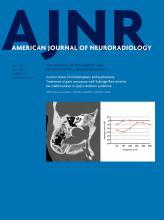Index by author
Yadav, R.R.
- Spine Imaging and Spine Image-Guided InterventionsYou have accessThe Importance of Flexion MRI in Hirayama Disease with Special Reference to Laminodural Space MeasurementsD.K. Boruah, A. Prakash, B.B. Gogoi, R.R. Yadav, D.D. Dhingani and B. SarmaAmerican Journal of Neuroradiology May 2018, 39 (5) 974-980; DOI: https://doi.org/10.3174/ajnr.A5577
Yang, P.-f.
- EDITOR'S CHOICENeurointerventionOpen AccessParent Artery Reconstruction for Large or Giant Cerebral Aneurysms Using the Tubridge Flow Diverter: A Multicenter, Randomized, Controlled Clinical Trial (PARAT)J.-m. Liu, Y. Zhou, Y. Li, T. Li, B. Leng, P. Zhang, G. Liang, Q. Huang, P.-f. Yang, H. Shi, J. Zhang, J. Wan, W. He, C. Liang, G. Zhu, Y. Xu, B. Hong, X. Yang, W. Bai, Y. Tian, H. Zhang, Z. Li, Q. Li, R. Zhao, Y. Fang and K. Zhao for the PARAT investigatorsAmerican Journal of Neuroradiology May 2018, 39 (5) 807-816; DOI: https://doi.org/10.3174/ajnr.A5619
This was a prospective, multicenter, randomized trial conducted at 12 hospitals throughout China. Enrolled adults with unruptured large/giant intracranial aneurysms were randomly assigned (1:1) to receive either Enterprise stent-assisted coiling or Tubridge flow diverter implantation. The primary end point was complete occlusion at 6-month follow-up, while secondary end points included technical success, mortality, target vessel–related stroke, aneurysm bleeding, in-stent stenosis, parent artery occlusion, and the frequency of all adverse events. The results of 6-month follow-up imaging included complete occlusion rates of 75.34% versus 24.53% for the Tubridge and stent-assisted coiling groups, respectively. This trial showed a higher rate of large and giant aneurysm obliteration with the Tubridgeflow diverter over Enterprise stent-assisted coiling. However, this higher obliteration rate came at the cost of a nonsignificantly higher rate of complications.
Yang, Q.-Z.
- Pediatric NeuroimagingYou have accessBrain Diffusion Abnormalities in Children with Tension-Type and Migraine-Type HeadachesJ.D. Santoro, N.D. Forkert, Q.-Z. Yang, S. Pavitt, S.J. MacEachern, M.E. Moseley and K.W. YeomAmerican Journal of Neuroradiology May 2018, 39 (5) 935-941; DOI: https://doi.org/10.3174/ajnr.A5582
Yang, X.
- EDITOR'S CHOICENeurointerventionOpen AccessParent Artery Reconstruction for Large or Giant Cerebral Aneurysms Using the Tubridge Flow Diverter: A Multicenter, Randomized, Controlled Clinical Trial (PARAT)J.-m. Liu, Y. Zhou, Y. Li, T. Li, B. Leng, P. Zhang, G. Liang, Q. Huang, P.-f. Yang, H. Shi, J. Zhang, J. Wan, W. He, C. Liang, G. Zhu, Y. Xu, B. Hong, X. Yang, W. Bai, Y. Tian, H. Zhang, Z. Li, Q. Li, R. Zhao, Y. Fang and K. Zhao for the PARAT investigatorsAmerican Journal of Neuroradiology May 2018, 39 (5) 807-816; DOI: https://doi.org/10.3174/ajnr.A5619
This was a prospective, multicenter, randomized trial conducted at 12 hospitals throughout China. Enrolled adults with unruptured large/giant intracranial aneurysms were randomly assigned (1:1) to receive either Enterprise stent-assisted coiling or Tubridge flow diverter implantation. The primary end point was complete occlusion at 6-month follow-up, while secondary end points included technical success, mortality, target vessel–related stroke, aneurysm bleeding, in-stent stenosis, parent artery occlusion, and the frequency of all adverse events. The results of 6-month follow-up imaging included complete occlusion rates of 75.34% versus 24.53% for the Tubridge and stent-assisted coiling groups, respectively. This trial showed a higher rate of large and giant aneurysm obliteration with the Tubridgeflow diverter over Enterprise stent-assisted coiling. However, this higher obliteration rate came at the cost of a nonsignificantly higher rate of complications.
Ye, J.
- FELLOWS' JOURNAL CLUBAdult BrainOpen AccessBrain MRI Characteristics of Patients with Anti-N-Methyl-D-Aspartate Receptor Encephalitis and Their Associations with 2-Year Clinical OutcomeT. Zhang, Y. Duan, J. Ye, W. Xu, N. Shu, C. Wang, K. Li and Y. LiuAmerican Journal of Neuroradiology May 2018, 39 (5) 824-829; DOI: https://doi.org/10.3174/ajnr.A5593
The authors enrolled 53 patients with anti-N-methyl-D-aspartate receptor encephalitis and performed 2-year follow-up. Brain MRIs were acquired for all patients at the onset phase. The brain MR imaging manifestations were classified into 4 types—type 1: normal MR imaging findings; type 2: only hippocampal lesions; type 3: lesions not involving the hippocampus; and type 4: lesions inboth the hippocampus and other brain areas. Twenty-eight (28/53, 53%) patients had normal MR imaging findings (type 1), and the others (25/53, 47%) had abnormal MRI findings—type 2: 7 patients (13%); type 3: 7 patients (13%); and type 4: 11 patients (21%). The presence of hippocampal lesions and relapse was associated with poor outcome.
Yeom, K.W.
- Pediatric NeuroimagingYou have accessBrain Diffusion Abnormalities in Children with Tension-Type and Migraine-Type HeadachesJ.D. Santoro, N.D. Forkert, Q.-Z. Yang, S. Pavitt, S.J. MacEachern, M.E. Moseley and K.W. YeomAmerican Journal of Neuroradiology May 2018, 39 (5) 935-941; DOI: https://doi.org/10.3174/ajnr.A5582
Yoneda, T.
- Adult BrainYou have accessSignal Change of Acute Cortical and Juxtacortical Microinfarction on Follow-Up MRIM. Miyata, S. Kakeda, T. Yoneda, S. Ide, K. Watanabe, J. Moriya and Y. KorogiAmerican Journal of Neuroradiology May 2018, 39 (5) 834-840; DOI: https://doi.org/10.3174/ajnr.A5606








